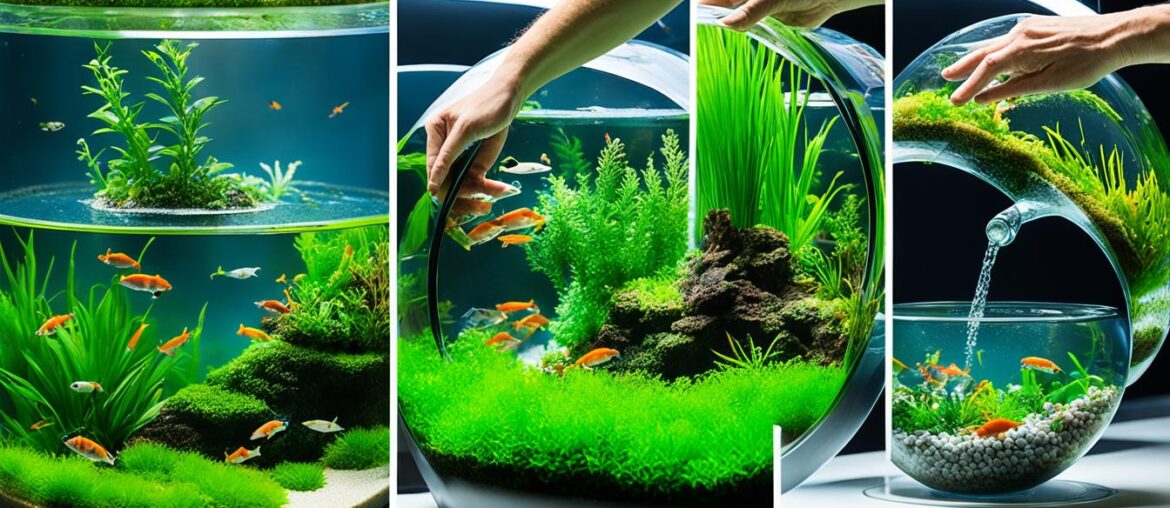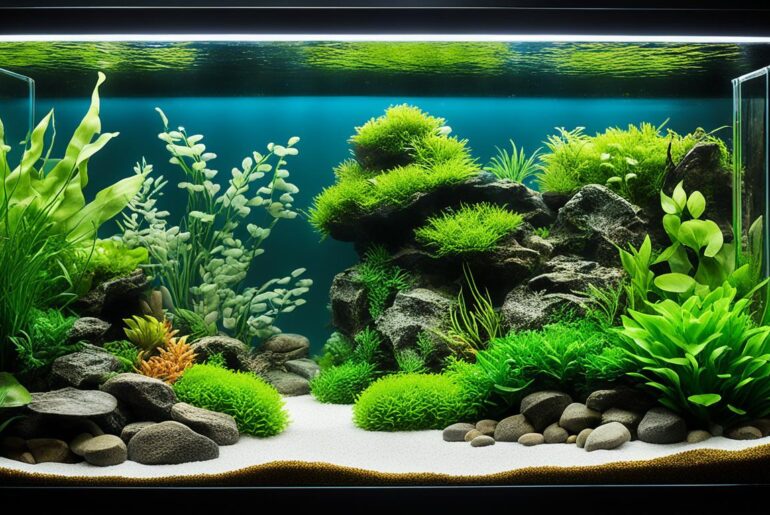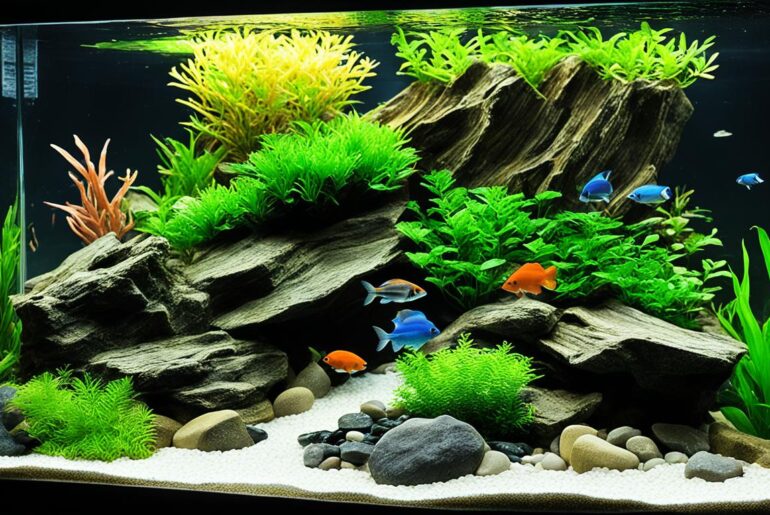As an aquarium enthusiast, I believe in creating a harmonious and sustainable environment for my aquatic friends. There’s something truly magical about watching vibrant fish swim gracefully through a lush underwater landscape. But, I also recognize the importance of preserving our planet and making eco-friendly choices in every aspect of life.
When I first started my journey into the world of aquariums, I was overwhelmed by the variety of substrate options available. I wanted to create a beautiful and natural habitat for my fish while also minimizing my impact on the environment. That’s when I discovered the wonders of eco-friendly substrate options for aquariums.
These sustainable substrate options not only provide a safe and stable base for aquatic life but also align with my values of environmental conservation. I have found that using eco-friendly substrates not only enhances the overall beauty of my aquarium but also contributes to a healthier and more balanced ecosystem.
Key Takeaways:
- Choosing eco-friendly substrate options for your aquarium is a great way to create a sustainable and environmentally friendly habitat for your aquatic friends.
- Eco-friendly substrates provide a safe and stable base for aquatic life while minimizing your impact on the environment.
- By using eco-friendly substrate options, you can enhance the overall beauty of your aquarium and contribute to a healthier and more balanced ecosystem.
- Consider opting for inert substrates or nutrient-rich substrates to meet the specific needs of your aquarium and aquatic plants.
- Remember to research and choose substrates that are compatible with the fish and plants in your aquarium for optimal results.
Understanding Substrate and Its Role in an Aquarium
When it comes to maintaining a healthy and thriving aquarium, one crucial element that often goes unnoticed is the substrate. The substrate refers to the material at the bottom of the aquarium, and it serves multiple purposes that are vital for the well-being of your aquatic ecosystem. Understanding the role and purpose of substrate is essential for creating a balanced and sustainable aquarium environment.
Traditional aquarium substrates, such as gravel, sand, and crushed coral, have long been popular choices among hobbyists. However, with the rise of eco-consciousness, many aquarists are now seeking alternatives that align with their values of sustainability and environmental responsibility. Inert substrates offer a great solution, providing all the benefits while minimizing harm to the environment and aquatic life.
So, what exactly is the role of substrate in an aquarium? Let’s explore its primary functions:
- Anchor for Plants: Substrate serves as a stable base for aquatic plants. It allows them to take root and establish themselves firmly in the aquarium. Without a suitable substrate, plants may struggle to anchor, compromising their growth and overall health.
- Habitat for Beneficial Bacteria: Beneficial bacteria play a vital role in maintaining water quality by breaking down toxic substances like ammonia and nitrites. Substrate provides a habitat for these bacteria to colonize and thrive, creating a natural biological filtration system that helps keep your aquarium healthy.
- Decorative Element: Substrate adds visual appeal to your aquarium, contributing to its overall aesthetic. With a wide range of substrate options available, you can choose colors, textures, and compositions that complement your desired look.
By understanding the importance of substrate in an aquarium, you can make informed decisions when selecting the right substrate for your setup. Inert substrates offer an eco-friendly and sustainable alternative to traditional options, ensuring a healthier and more environmentally conscious aquarium environment.
“Substrate is the foundation of your aquarium, providing stability, a habitat for beneficial bacteria, and a beautiful backdrop for your aquatic plants and fish.” – Me
Inert Substrates: What Are They?
Inert substrates are a class of aquarium substrates that do not alter the chemistry of the water. They are chemically stable and do not release or absorb elements that could impact the water’s pH, hardness, or other chemical parameters.
Examples of inert substrates include:
- Aragonite sand
- Quartz sand
- River rocks
- Glass beads
- Pool filter sand
These substrates provide a natural look while maintaining water chemistry stability.
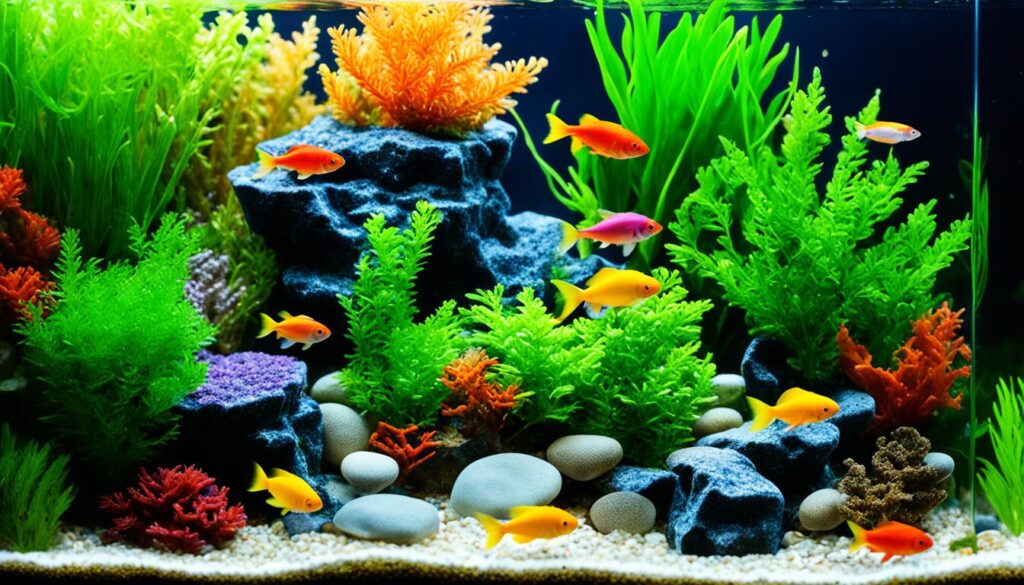
Why Choose Inert Substrates?
When it comes to creating a sustainable and eco-friendly aquarium, choosing the right substrate is crucial. Inert substrates offer a multitude of benefits that make them an excellent choice for eco-conscious aquarists. Let’s explore the advantages of these eco-friendly substrates and the reasons why you should consider using them in your aquarium setup.
Maintain Stable Water Parameters
Inert substrates are chemically stable and do not alter the water’s chemistry. This means that they do not release or absorb elements that could impact the pH level, water hardness, or other chemical parameters. By maintaining stable water parameters, inert substrates provide a consistent and balanced environment for your aquatic life.
Compatibility with a Wide Range of Fish and Aquatic Plants
One of the key advantages of inert substrates is their compatibility with various fish species and aquatic plants. Unlike some traditional substrates that may have specific requirements or limitations, inert substrates can be used in a wide range of aquarium setups. Whether you have a freshwater or marine aquarium, inert substrates offer a versatile option that suits different types of aquatic life.
Sourced Sustainably
Eco-conscious aquarists prioritize sustainability, and inert substrates align perfectly with this principle. Many inert substrate options, such as aragonite sand, quartz sand, and river rocks, are sourced sustainably from natural deposits. By choosing inert substrates, you can have peace of mind knowing that your aquarium is not contributing to the depletion of natural resources.
Easy to Clean and Maintain
Inert substrates are known for their ease of maintenance. Unlike some traditional substrates that may require frequent rinsing or vacuuming, inert substrates are relatively low-maintenance. They do not trap debris or waste, making it easier to keep your aquarium clean and maintain optimal water quality.
Safe for Fish
Another advantage of using inert substrates is that they are safe for fish. Inert substrates do not release any harmful substances into the water, ensuring the well-being and health of your aquatic pets. The smooth texture of many inert substrates also minimizes the risk of fish injury, providing a safe and comfortable environment for them to thrive.
Suitable Habitat for Beneficial Bacteria
Beneficial bacteria play a crucial role in maintaining a healthy aquarium ecosystem. Inert substrates provide an ideal habitat for these beneficial bacteria to thrive. The surface area and porous nature of many inert substrates promote the growth of beneficial bacteria, which help break down waste and maintain water quality.
With all these benefits in mind, it’s clear why choosing inert substrates is a wise decision for eco-conscious aquarists. These substrates offer stability, compatibility, sustainability, easy maintenance, and safety for fish, while also providing a suitable habitat for beneficial bacteria. By opting for eco-friendly substrates, you can create a beautiful and environmentally friendly aquarium that promotes the well-being of your aquatic friends.
“Choosing inert substrates allows aquarists to create a sustainable and environmentally friendly aquarium.”
Setting Up Your Aquarium with Inert Substrate
Setting up your aquarium with inert substrate is a straightforward process that ensures a healthy and eco-friendly environment for your aquatic friends. Follow these simple steps to create the perfect habitat:
- Clean the tank: Before adding the substrate, ensure that the tank is clean and free from any debris or residues. This will provide a clean surface for the substrate and prevent any potential contamination.
- Rinse the substrate: It is essential to rinse the inert substrate thoroughly before adding it to the aquarium. This helps remove any dust or fine particles that may cloud the water.
- Add the substrate: Gently pour the rinsed substrate into the bottom of the aquarium. You can create a uniform layer or create slopes and varying depths, depending on your preferred design.
- Decorate and plant: Now is the perfect time to add any decorations, such as rocks, driftwood, or artificial plants, to enhance the aesthetic appeal of your aquarium. If you plan to have live plants, plant them carefully into the substrate, taking care not to disturb it too much.
- Cycle the aquarium: To establish a healthy environment for your fish, it’s crucial to cycle the aquarium before adding any inhabitants. This process allows beneficial bacteria to colonize the substrate and filter the water effectively. Monitor water parameters regularly during the cycling process.
Remember to maintain optimal water parameters regularly by testing pH, ammonia, nitrite, and nitrate levels. This will ensure a stable and thriving aquarium environment for your fish and plants.
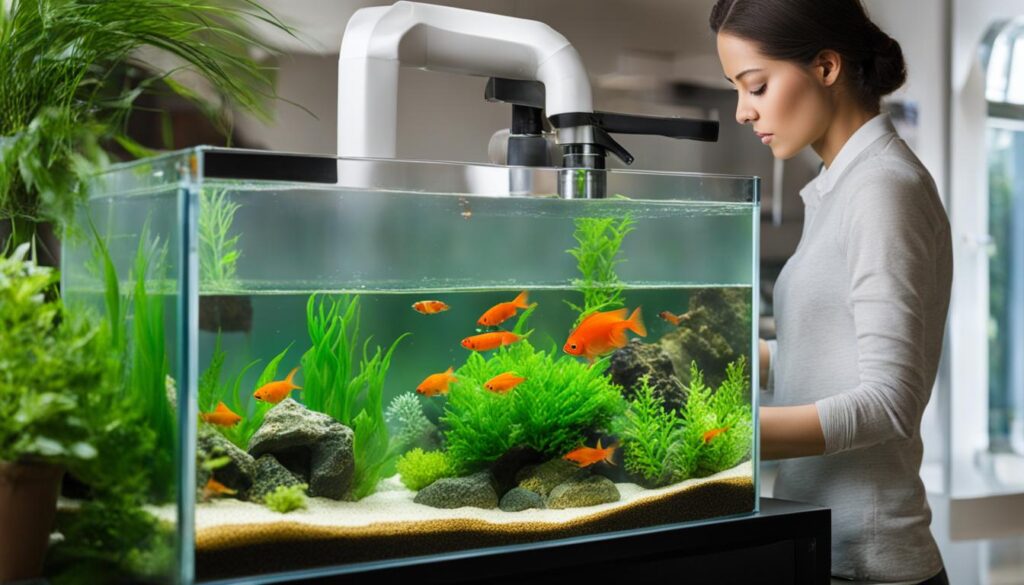
Nutrient-Rich Substrates for Planted Tanks
When it comes to creating a thriving planted tank, choosing the right substrate is essential. Nutrient-rich substrates specifically designed for planted tanks provide the essential nutrients that plants need to grow and flourish. These substrates are formulated to meet the unique requirements of aquatic plants, ensuring optimal growth and development.
Two popular examples of nutrient-rich substrates for planted tanks are ADA Aqua Soil and Aquavitro Aquasolum. These substrates offer a range of benefits for both plants and the overall aquarium environment.
Benefits of Nutrient-Rich Substrates:
| Benefits | Description |
|---|---|
| 1. pH Regulation | Nutrient-rich substrates tend to lower the pH of the water, creating a favorable environment for many plant species. |
| 2. Soften Water Hardness | These substrates also help to naturally soften water hardness, making them suitable for aquariums with crystal shrimp and other sensitive species. |
| 3. Ideal for Root-Feeding Plants | Nutrient-rich substrates are particularly beneficial for plants that rely heavily on root absorption for nutrient uptake. |
| 4. Enhanced Plant Growth | The abundance of essential nutrients in these substrates promotes vigorous plant growth, leading to lush and healthy aquarium displays. |
While nutrient-rich substrates offer numerous advantages, it’s important to note that over time, they can become depleted of nutrients and may even become muddy. To mitigate this, it’s recommended to supplement the substrate with root tabs or liquid fertilizers to ensure plants continue to receive the necessary nutrients for sustained growth. Regular monitoring and maintenance are key to maintaining a thriving planted tank with nutrient-rich substrates.
Now let’s take a closer look at the benefits of using inert substrates in planted tanks, as they offer a different set of advantages for aquarists seeking sustainable substrate options.
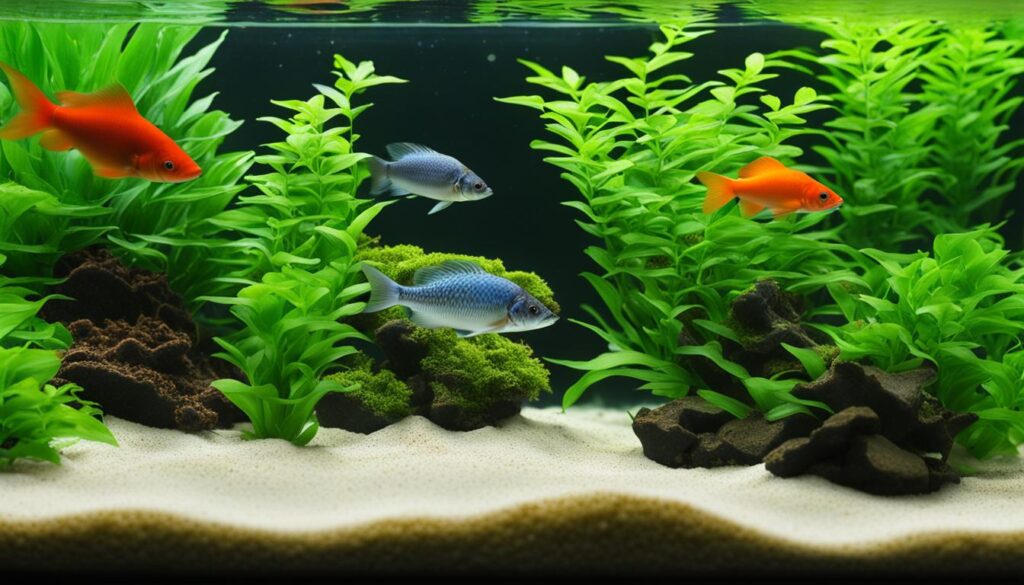
Inert Substrates for Planted Tanks
Inert substrates, such as gravel or pebbles, are a versatile option for planted tanks. Unlike other substrates, they do not alter the chemistry of the water, making them ideal for creating a stable and healthy environment for your plants. These inert substrates provide a stable base for plant roots to anchor, allowing them to grow and thrive.
One of the benefits of using inert substrates in planted tanks is their compatibility with a variety of plant species. Whether you have stem plants, carpeting plants, or root feeders, inert substrates provide a suitable foundation for all types of plants. They also allow for easy repositioning or rearranging of plants as needed.
To maximize the growth and health of your plants, you can combine inert substrates with nutrient-rich substrates or use them in conjunction with all-in-one liquid fertilizers. This combination ensures that your plants receive the necessary nutrients for growth while benefiting from the stability and anchorage provided by the inert substrate.
When choosing inert substrates for your planted tank, it is important to consider the particle size. Extreme particle sizes can affect water circulation and root penetration. It is recommended to opt for a medium-sized substrate that strikes a balance between water circulation and optimal root growth.
Overall, using inert substrates in planted tanks offers several benefits. They provide stability, compatibility, and a neutral environment for plant growth. Whether you are a beginner or an experienced aquarist, inert substrates are a reliable and versatile choice for creating a flourishing planted tank.
Benefits of Inert Substrates for Plants:
- Stability: Inert substrates provide a stable base for plant roots to anchor, allowing for optimal growth and development.
- Compatibility: They are compatible with a wide range of plant species, making them suitable for various planting arrangements.
- Neutral Environment: Inert substrates do not alter water chemistry, creating a neutral environment for plants.
- Easy Maintenance: Inert substrates require minimal maintenance and can be easily cleaned without affecting plant health.
- Versatility: They can be combined with nutrient-rich substrates or used with all-in-one liquid fertilizers to provide plants with necessary nutrients for growth.
Inert Substrates for Planted Tanks – Comparison Table
| Substrate Material | Particle Size | Compatibility with Plants | Key Features |
|---|---|---|---|
| Gravel | Medium | Compatible with most plant species | Durable and aesthetically pleasing |
| Pebbles | Medium-Large | Provides good water circulation for roots | Natural appearance |
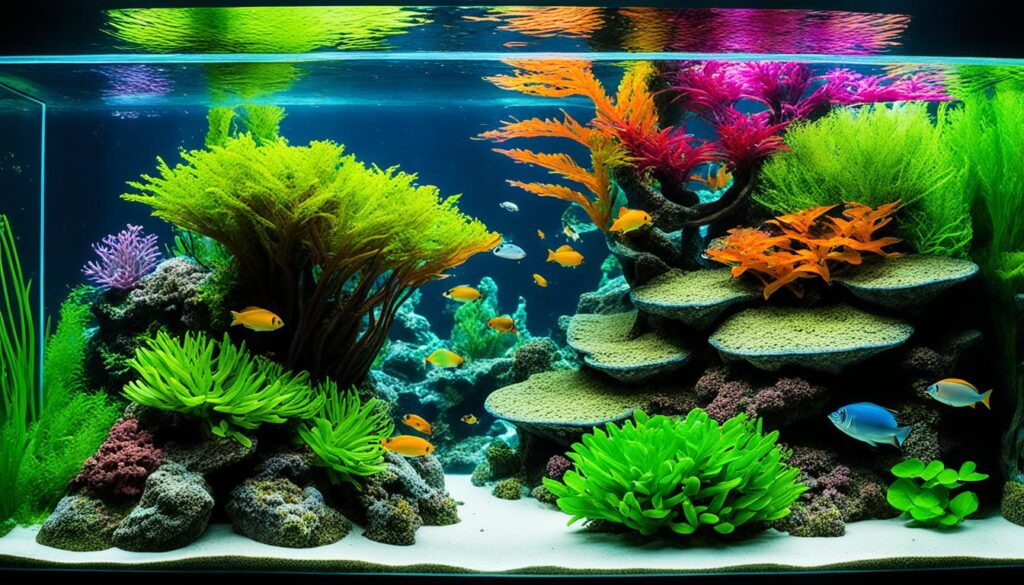
Other Substrate Options for Freshwater Aquariums
In addition to inert and nutrient-rich substrates, there are various other options available for freshwater aquariums. These alternative aquarium substrates provide unique features and benefits that can enhance the overall aquatic environment. Let’s explore some unconventional aquarium substrates:
Sand
Sand is a popular choice for aquariums due to its natural look and ease of cleaning. It creates a soft and comfortable substrate for fish and provides a smooth surface for bottom-dwelling species. Sand also allows for natural burrowing behaviors and is suitable for delicate plants with fine roots.
Aragonite
Aragonite is a type of calcium carbonate substrate that not only adds aesthetic appeal but also helps maintain pH levels in the aquarium. It buffers the water and stabilizes the pH, making it suitable for tanks with sensitive species like African cichlids.
Vermiculite
Vermiculite is a lightweight, porous substrate that holds moisture well. It promotes plant growth by providing a favorable environment for root development and water retention. Vermiculite also aids in maintaining humidity levels, making it ideal for terrariums or vivariums.
Peat Moss
Peat moss is known for its water-softening properties. It naturally releases tannins, organic acids, and humic substances, creating an environment that replicates the natural habitats of many fish species. Peat moss is particularly beneficial for soft water-loving fish and plants that thrive in acidic conditions.
Coral
Used primarily in marine aquariums, coral substrates not only serve as a decorative element but also help maintain stable water parameters. Coral contains essential minerals and trace elements that benefit coral growth and overall reef health.
Marbles
Marbles can be used as a substrate in breeding tanks or for aesthetic purposes. Their smooth surface prevents the accumulation of debris and makes cleaning easier. Marbles also add a touch of color and texture to the aquarium, creating an attractive display.
Clay
Clay substrates are beneficial for plant growth and water filtration. They provide essential nutrients, such as iron and other trace elements, to plant roots. Clay substrates also help in maintaining water clarity by adsorbing impurities and improving overall water quality.
To help you visualize these alternative aquarium substrates, here is a table summarizing their unique characteristics:
| Substrate | Characteristics |
|---|---|
| Sand | Natural look, easy to clean, suitable for delicate plants |
| Aragonite | Buffer pH, suitable for sensitive species like African cichlids |
| Vermiculite | Lightweight, promotes root growth, ideal for terrariums |
| Peat Moss | Softens water, replicates natural habitats, benefits acidic-loving fish |
| Coral | Decorative, supports stable water parameters, essential for coral reefs |
| Marbles | Easy to clean, decorative, suitable for breeding tanks |
| Clay | Nutrient-rich, enhances plant growth, improves water quality |
With such a variety of alternative aquarium substrates available, you can choose the one that best meets your aesthetic preferences, fish species, and desired water parameters. These unconventional options provide unique benefits and can help create a captivating and thriving underwater world in your aquarium.

In Summary
Exploring beyond traditional substrates opens up a world of possibilities for aquarium enthusiasts. From sand to vermiculite, each substrate offers distinct advantages that can enhance the health and appearance of your aquarium. Whether you prioritize aesthetics, plant growth, or water chemistry, one of these alternative substrates is sure to fit your needs.
Using Multiple Substrate Layers for Optimal Aquarium Environment
As an aquarist, I often prefer to utilize multiple layers of various substrates in my aquariums. This technique allows me to customize the environment and create a more natural habitat for my aquatic pets. By using a combination of substrates, I can provide the ideal foundation for both plants and fish, ensuring their well-being and enhancing the overall aesthetics of the tank.
For instance, I start by adding a bottom layer of nutrient-rich peat moss or aquarium soil. This layer serves as a foundation for plant growth, providing essential nutrients and supporting their root systems. On top of this base, I then incorporate a layer of gravel or pebbles. This top layer acts as a stable substrate for fish, allowing them to move and interact with their environment comfortably.
By implementing multiple substrate layers, I can create an ecosystem that closely resembles the natural habitats of aquatic species. This not only benefits the overall health and happiness of the inhabitants but also adds visual interest and diversity to the aquarium.
Benefits of using multiple substrate layers:
- Enhanced nutrient availability for plant growth.
- Improved stability for fish movement and behavior.
- Increase in overall visual appeal and natural aesthetics.
- Promotion of a diverse aquatic ecosystem.
I find this method particularly effective when creating themed aquariums or replicating specific aquatic environments. For example, in a planted tank, the combination of nutrient-rich substrate and stable top layer mimics the fertile riverbeds or forest floors, providing the ideal conditions for lush plant growth.
I believe that using multiple substrate layers not only benefits the well-being of the aquatic inhabitants but also enhances the overall experience of owning an aquarium. It allows me to create a captivating and harmonious environment that closely resembles the natural habitats of the species I keep.
As with any aquarium setup, it is essential to research the specific needs of your aquatic plants and fish to ensure you select the appropriate substrates. Additionally, regular maintenance and monitoring of water parameters are crucial for maintaining a healthy and thriving aquarium.
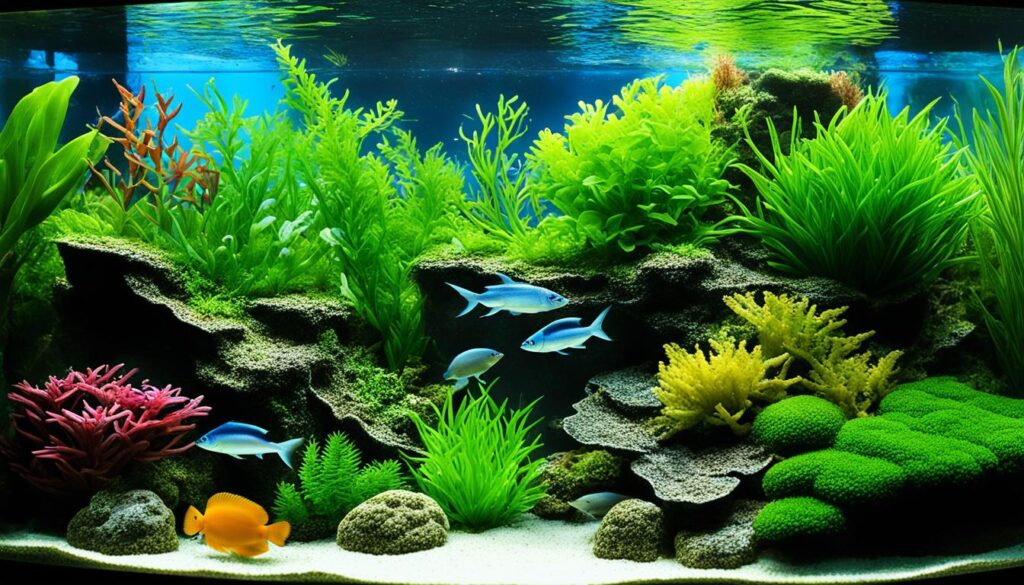
By using multiple substrate layers, aquarists like myself can achieve an optimal aquarium environment that promotes the well-being of both flora and fauna. This method allows for customization, creating a diverse and natural habitat. Whether you’re aiming for a lush planted tank or a vibrant community of fish, experimenting with different combinations of substrates can help you achieve the perfect balance within your aquarium.
| Benefits of Using Multiple Substrate Layers | |
|---|---|
| Enhanced nutrient availability | Optimal growing conditions for plants |
| Improved stability | Enhanced fish movement and behavior |
| Visual appeal | Natural aesthetics and diversity |
| Ecosystem replication | Mimicking natural aquatic habitats |
Substrate Additives for Enhanced Aquarium Environment
When it comes to creating a thriving and vibrant aquarium, substrate additives play a crucial role. These additives, such as root tabs or clay pellets, not only enhance the overall environment but also provide additional nutrients that are essential for the health and growth of your aquatic plants.
Root tabs are specifically designed to deliver nutrients directly to the roots of your plants. By placing these tabs in the substrate, you ensure that your plants receive a constant supply of essential elements, promoting lush and vibrant growth. The nutrients released by root tabs help in stimulating root development, improving nutrient uptake, and overall plant health.
Clay pellets are another valuable substrate additive that can greatly improve the well-being of your aquarium. These pellets are known for their ability to enhance water filtration and ammonia absorption. By incorporating clay pellets into your substrate, you create a more efficient and cleaner aquatic ecosystem. Additionally, clay pellets can act as a nutrient reservoir, slowly releasing essential minerals over time, resulting in healthier plants and a thriving aquatic environment.
To maximize the benefits of substrate additives, consider using them in conjunction with different substrate materials. By combining root tabs or clay pellets with inert substrates or nutrient-rich substrates, you can create a well-balanced and dynamic aquarium setup that promotes optimal plant growth and a healthy aquatic habitat.
Key Benefits of Substrate Additives:
- Enhanced nutrient availability for plants
- Stimulated root development and growth
- Improved water filtration and ammonia absorption
- Promoted overall plant health
- Creation of a well-balanced and thriving aquarium environment
By incorporating substrate additives into your aquarium setup, you can take your aquatic hobby to the next level. These beneficial additives not only enhance the aesthetic appeal of your tank but also contribute to the overall health and well-being of your aquatic plants and inhabitants.
Next, we will explore various options for setting up your aquarium with nutrient-rich substrates specifically designed for planted tanks.
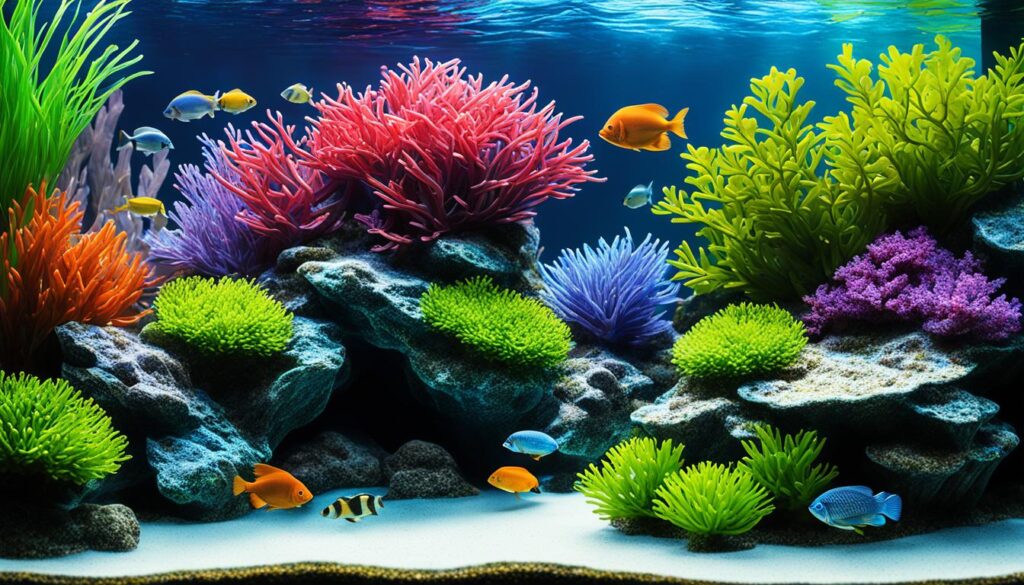
Conclusion
In conclusion, when it comes to choosing substrate for your aquarium, there are several eco-friendly options to consider. Inert substrates like aragonite sand, quartz sand, river rocks, glass beads, and pool filter sand provide stability, compatibility, and sustainability, making them a popular choice among eco-conscious aquarists. These substrates do not alter the chemistry of the water and offer a safe and natural habitat for your aquatic friends.
For those looking to create a planted tank, nutrient-rich substrates like ADA Aqua Soil and Aquavitro Aquasolum are specifically designed to provide essential nutrients for plant growth. However, it is important to note that these substrates may require reinvigoration over time to maintain their nutrient levels.
If you prefer other options, sand, aragonite, vermiculite, peat moss, coral, marbles, and clay are also available. Each of these substrates offers different benefits for specific needs, such as providing a natural look, maintaining pH levels, promoting plant growth, or facilitating water filtration.
By selecting the right substrate for your aquarium, you can create a sustainable and environmentally friendly habitat that not only supports the health and well-being of your aquatic life but also adds beauty and tranquility to your space.
FAQ
What are some eco-friendly substrate options for aquariums?
Some popular eco-friendly substrate options for aquariums include inert substrates such as aragonite sand, quartz sand, river rocks, glass beads, and pool filter sand. These substrates are sustainable and do not harm the environment or aquatic life.
What is the role of substrate in an aquarium?
Substrate in an aquarium serves several purposes, including anchoring plants, providing a habitat for beneficial bacteria, and acting as a decorative element. It plays a crucial role in maintaining a healthy and thriving aquarium environment.
What are inert substrates and how are they different?
Inert substrates are a class of aquarium substrates that do not alter the chemistry of the water. They are chemically stable and do not release or absorb elements that could impact the water’s pH, hardness, or other chemical parameters. Examples of inert substrates include aragonite sand, quartz sand, river rocks, glass beads, and pool filter sand.
Why should I choose inert substrates for my aquarium?
There are several reasons to choose inert substrates for your aquarium. Inert substrates maintain stable water parameters, are compatible with a wide range of fish and aquatic plants, sourced sustainably, easy to clean and maintain, safe for fish, and provide a suitable habitat for beneficial bacteria. These benefits make inert substrates an excellent choice for creating a sustainable and environmentally friendly aquarium.
How do I set up my aquarium with inert substrate?
To set up your aquarium with inert substrate, start by cleaning the tank thoroughly. Rinse the substrate under running water to remove any dust or debris. Add the substrate to the bottom of the aquarium and distribute it evenly. Decorate and plant as desired. Finally, cycle the aquarium before adding fish to ensure a stable and healthy ecosystem.
What are nutrient-rich substrates and when should I use them?
Nutrient-rich substrates are specifically designed for planted tanks and provide essential nutrients for plant growth. Examples include ADA Aqua Soil and Aquavitro Aquasolum. These substrates are ideal for aquariums with heavy root-feeding plants and can help lower pH and soften water hardness.
Can I use inert substrates in planted tanks?
Yes, inert substrates such as gravel or pebbles can be used in planted tanks. While they do not alter water chemistry, they provide a stable base for plant roots to anchor. Inert substrates can be combined with nutrient-rich substrates or used with all-in-one liquid fertilizers to provide plants with the necessary nutrients for growth.
What other substrate options are available for freshwater aquariums?
In addition to inert and nutrient-rich substrates, there are other substrate options available for freshwater aquariums. These include sand, aragonite, vermiculite, peat moss, coral, marbles, and clay. Each substrate has its own benefits and may be suitable for specific needs or preferences.
Can I use multiple layers of different substrates in my aquarium?
Yes, many aquarists prefer to use multiple layers of different substrates in their aquariums. This allows for customization and the creation of a more natural environment. For example, a bottom layer of peat moss or aquarium soil can be topped with gravel or pebbles, providing a nutrient-rich base for plants and a stable substrate for fish.
Are there any additives that can enhance the aquarium environment?
Yes, there are substrate additives available that can enhance the aquarium environment. Root tabs can be placed in the substrate to provide nutrients directly to plant roots, while clay pellets can improve water filtration and ammonia absorption. These additives can be used in conjunction with different substrate materials to create a well-balanced and thriving aquarium.
How can I create a sustainable and eco-friendly aquarium?
By selecting eco-friendly substrate options such as inert substrates, using sustainable practices, and choosing environmentally friendly products, you can create a sustainable and eco-friendly aquarium. Regularly maintaining water parameters and providing a healthy habitat for fish and plants are also important factors in maintaining an eco-conscious aquarium.
